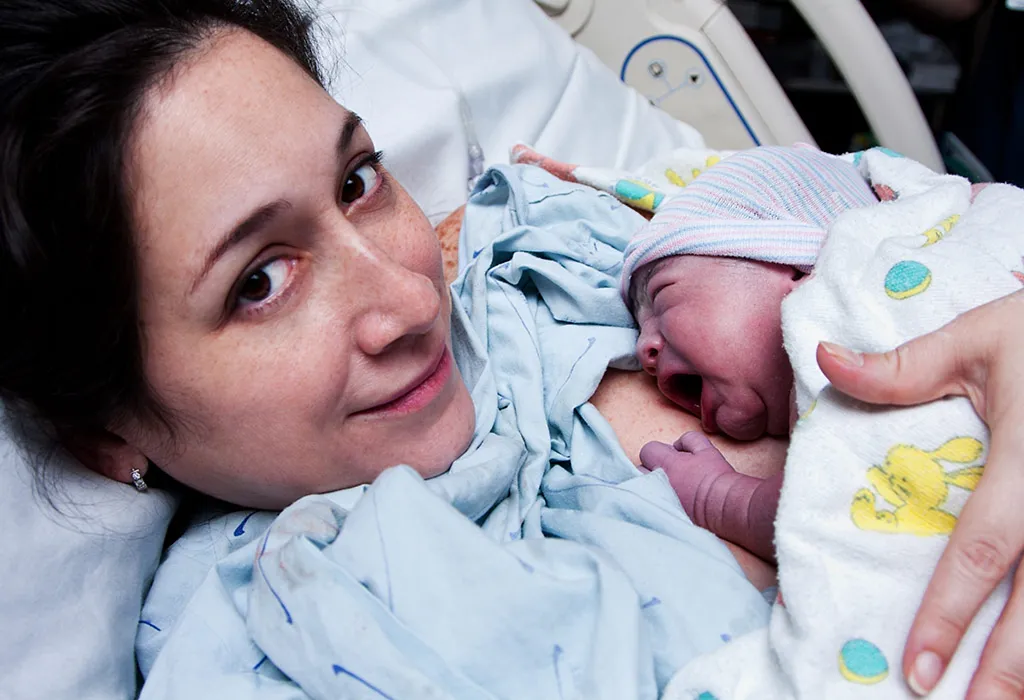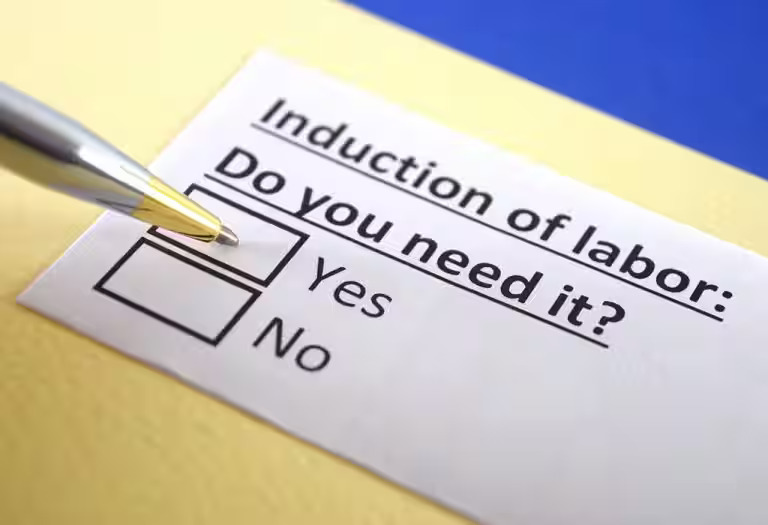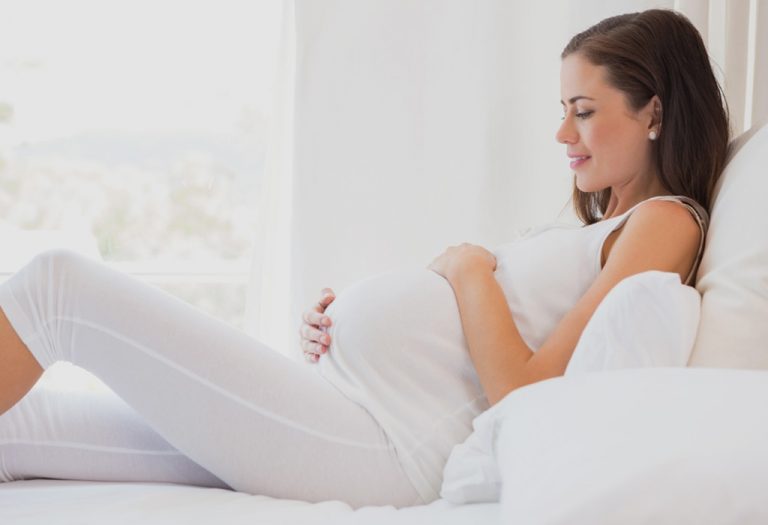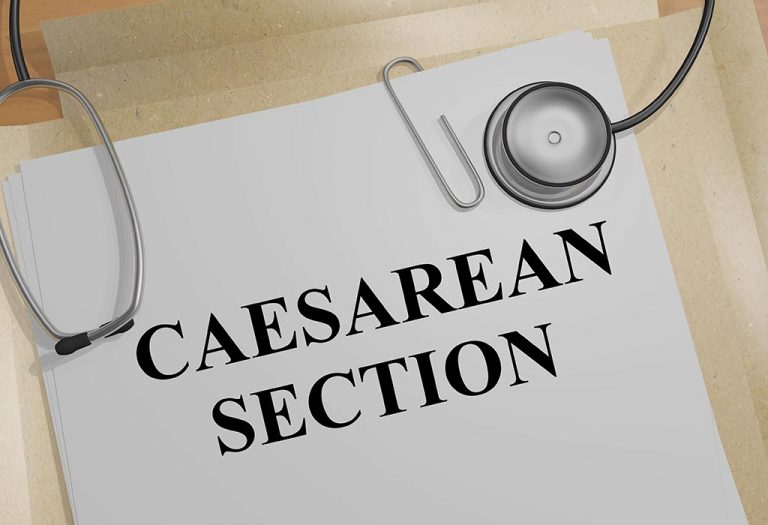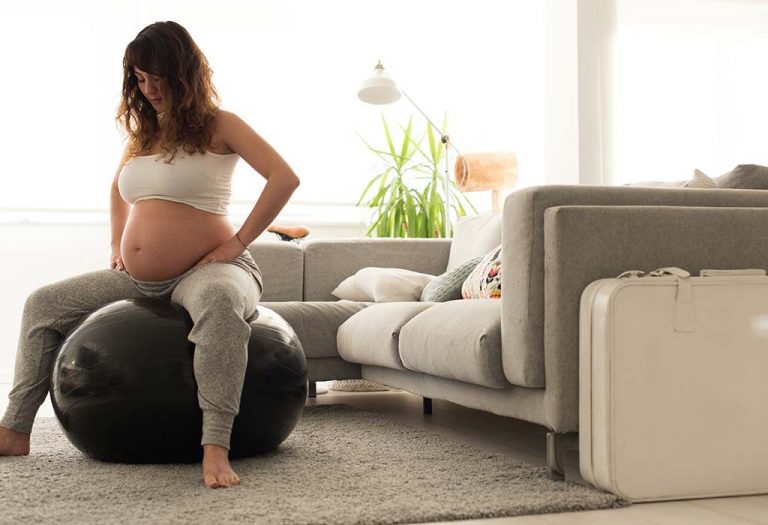Labour Pain: What Does It Actually Feel Like
Labour is both an intriguing and intimidating experience. The thought of finally bringing your child into this world, coupled with the associated pain, sparks off a rainbow of emotions that includes anxiety, fear, and excitement. Most women wonder how bad labour pain is and what contractions feel like (1). However, labour is an extremely individualistic experience, and each mother undergoes different levels of pain and discomfort. The process of delivery labour pain can vary widely. Factors such as the baby’s position, the mother’s pain tolerance, and the use of pain relief methods also play a significant role in shaping the experience.
Labour in Pregnancy
Here’s the labour pain meaning. Labour is a process that the mother goes through for delivering the baby and is often associated with pain. You can deliver in two ways, vaginally (naturally through the birth canal) or cesarean (surgical procedure) (2) (3). We will describe the most common experiences shared by mothers during different stages of labour that can help you prepare yourself for the most memorable day of your life.
What Do Labour Pains Feel Like?
Till your moment of labour arrives, nobody can accurately predict what your labour will be like since the experience is unique for each mother. But before you dig deep into the concept of labour and imagine what contractions feel like, it is ideal to understand labour stages.
Labour can be bifurcated into three stages with unique phases: The first stage of pre-labour and early labour; the second stage of active labour, transition, pushing; and the final stage, which includes delivery of the placenta (4).
During the Pre-Labour Stage
The pre-labour stage often starts with Braxton-Hicks (false labour) contractions mistaken for actual labour (5). In some cases, these can be experienced much earlier in pregnancy, at around 20 weeks. Mothers carrying more than one child can feel these even earlier. Named after an English doctor John Braxton Hicks, these pre-labour contractions are considered practice before the actual event that helps prepare the baby and mother for the delivery. Such cramping is not regular, is painless, and does not cause the cervix to dilate.
Early-labour contractions can occur due to extreme activity, absence of water(dehydration), or hunger and stress. These pre-labour pains are often felt in separate spots instead of the whole uterus. The feelings are like plain baby activities or gas, but again the experience is distinctive.
During Early Labour (First Stage)
This phase is the beginning of the labour process. Thinking what labour feels like at this stage? The pre-labour contractions are not regular, while early labour tightenings, often described as the onset of labour, are regular but not too close and usually don’t subside if you eat, drink water, rest, or give enema. Such early labour pains are noticeable and stay for a lesser duration, and are not very intense. Early contractions can feel like recurring menstrual cramps in labour.
At this juncture, if you feel the contractions are occurring at almost regular intervals and the cervix begins to dilate and efface, you have officially entered labour (6). Labour contractions at the early stages are sometimes hard to distinguish from the inefficient Braxton Hicks contractions or false labour pains felt in the previous phase.
The onset of regular and consistent contractions is the time to be excited because it means labour is imminent, and the nine-month journey will culminate into birthing. At the outset, there are breaks of longer duration between contractions, often five or 20 minutes break, and each contraction may last 40 to 60 seconds. These are signs for the to-be parents to prepare for the stages ahead.
During Active Labour
You enter into active labour when contractions become more regular, long, and prominent (7). This is supposed to be the toughest part of labour, where the cervix starts dilating and opens up to make way for the baby to move down. You will start feeling heavy in your lower abdomen as the baby twists and come downwards, exerting a force on the cervix.
The contractions in active labour appear closer together and are often at a gap of around five minutes but hold up for about a minute. These often cause lower backache that shoots painful sensations down the legs. A cycle of cramps that come and leave with the contraction also begins in this phase.
The uterus actively pushes the baby onto the cervix, causing it to dilate, allowing the baby to slip further down. Some feel this as contractions in their stomach area while it may be experienced at the opening of the cervix. However, the real contractions are felt in the stomach radiating from one point on the uterus to throughout the uterus; additional pain may be felt around the cervix.
During the intervals, you should take a breath, eat and relax as it is overwhelming for the mother. The support of your husband or a family member at this phase can be of great help because you are expected to deal with the intensity of regular contractions.
The phase can stretch between four to eight hours (especially for first-timers), while it can even take longer for many. Only a lucky few have it as a short one-hour experience!
For mothers who have had a natural delivery or those getting oxytocin (Pitocin), the phase is usually shorter. Many women also opt for medication in this phase. However, just like the baby’s size, the use of an epidural may increase the duration of the phase.
Transition Phase
Most women fear this part as it comes right before the pushing in labour and can be a period of rapid opening (8). This is the phase where your cervix dilates to around 10 centimeters. This is the transition between initial labour and the final pushing when the baby starts to arrive, and for some women, this can be painful and overwhelming. However, this transition phase typically lasts between 15 to 30 minutes, going up to a few hours in some cases.
The spaced-out contractions of earlier phases now increase in intensity and are so close together that they seem to be overlapping or even peaking simultaneously. Shivers and vomiting can supplement this stage as your baby starts slipping into a position ideal for birth.
Even as the doctor asks you to be focused emotionally, you may feel like giving up during this phase. Try and remind yourself that this stage is the most crucial and try opening up to the pressure so that your baby descends as the cervix dilates fully. The transition phase is short-lived and rewarding because, towards the end, you can hold your baby in your arms.
During Pushing (Second Stage of Labour)
Now, you enter the stage where you will be asked to push once the cervix gets completely dilated with all your strength. This is the ultimate descent when the baby comes out. At this stage, you may feel the contractions are at a gap, giving you time to take a rest between each contraction.
In fact, some women find it easy to tighten in this phase than in active labour because pushing down is relieving. For some, it could be a painless experience, while some are exhausted by pushing. Most mothers describe the pushing phase as similar to the need to poop because the baby exerts pressure on similar organs and causing the same reactions at the time of defecation. This urge instinctively directs the body to continue pushing the baby out effectively (9).
There is an urge to push early during the second stage or before that if the baby happens to be lower in the pelvis. But if the baby remains on top, you won’t get the feeling to push immediately.
If you manage to pull through the transition labour without drugs, then you will be more alert and participate in this active part of labour. If you manage to keep upright positions, it will make the process easier and physically less taxing.
As the phase progresses, you will encounter the process of crowning when the baby’s head comes out. By now, the urge to push becomes so strong that you will be guided to blow or pant during contractions to help counter it. You may experience a sensation known as a ‘ring of fire‘ at the time of crowning as the vagina tissues tightly stretch over the baby’s head. This brief but painful sensation is helpful because mothers tend to stop pushing and letting the tissues stretch over the baby’s head gently. A slow and controlled delivery can help to prevent tearing of your perineum. The entire second stage can take from a few minutes to several hours. This is also the time episiotomy is given by the doctor if required.
After Birth (Third-stage Labour)
The last stage is basically when you deliver the placenta (10). Some mothers hardly observe this part. At this stage, breastfeeding can ensure contraction of the uterus post-delivery and cause after-pains or slight contractions. Once detached, the placenta rests in the uterus and makes you feel heavy but delivering it gives you relief as the process is almost painless since it comes off easily. On average, the third stage of labour should not take more than five to 10 minutes.
How to Decrease Pain During Childbirth
Childbirth is a transformative yet challenging experience, and managing pain during labour is a common concern for many expectant mothers. Fortunately, there are various techniques and strategies, both medical and natural, that can help alleviate discomfort and make the process more manageable (11).
Before Giving Birth
1. Practice Prenatal Yoga and Stretching
Engaging in prenatal yoga or gentle stretching exercises can help improve flexibility, reduce muscle tension, and promote relaxation. These activities also prepare your body for labour by strengthening the muscles needed during childbirth.
2. Use Breathing and Relaxation Techniques
Learning deep breathing exercises and relaxation methods, such as meditation or guided imagery, can help manage anxiety and reduce perceived pain. These techniques are often taught in childbirth classes and can be practised regularly before labour.
3. Consider Prenatal Massage
Regular prenatal massages can alleviate back pain, improve circulation, and reduce stress. A trained therapist can focus on areas like the lower back and hips, which often bear the brunt of discomfort during pregnancy.
4. Stay Hydrated and Maintain a Balanced Diet
Proper hydration and a nutritious diet can help keep your body strong and reduce the risk of complications. Eating foods rich in magnesium, for example, may help prevent muscle cramps and ease tension as your due date approaches.
During Labour
1. Use Breathing Techniques
Focused breathing, such as slow, deep breaths or patterned breathing, can help you stay calm and manage pain during contractions.
2. Try Different Labor Positions
Changing positions, such as squatting, kneeling, or using a birthing ball, can help ease discomfort and encourage the baby to move through the birth canal more effectively.
3. Apply Heat or Cold Therapy
A warm compress or heating pad on the lower back can relieve tension, while a cold pack can numb pain and reduce swelling in specific areas.
4. Receive Counter-Pressure Massage
A partner or doula can apply firm pressure to your lower back during contractions to alleviate back labour pain.
5. Use Hydrotherapy
Soaking in a warm bath or standing under a shower can relax your muscles and provide significant pain relief during labour.
6. Practice Visualization and Mindfulness
Visualizing a calm, positive scene or focusing on mindfulness techniques can help distract from pain and reduce anxiety.
7. Consider Pain Relief Medications
Options like epidurals or analgesics can be discussed with your healthcare provider to help manage severe pain during labour.
8. Utilize Aromatherapy
Essential oils like lavender or peppermint can promote relaxation and reduce stress when used safely during labour.
9. Stay Hydrated and Nourished
Sipping water or clear fluids and eating light snacks, if allowed, can help maintain your energy levels throughout labour.
10. Listen to Music or Use Distraction Techniques
Playing calming music or focusing on a distracting activity can help shift your attention away from the pain.
11. Communicate with Your Support Team
Clear communication with your partner, doula, or medical team ensures your needs are met and helps you feel more in control.
12. Follow Your Body’s Cues
Trusting your instincts and moving or resting as your body directs can help you manage pain more effectively during labour.
Can Labour Pain Have Negative Effects on the Body?
Labour pain can impact both the mother and the baby, but in most cases, if both are healthy, they can manage it effectively without adverse outcomes. However, the pain often leads to rapid, shallow breathing, which reduces oxygen flow to the uterus. This can hinder labour progression and result in abnormal fetal heart rates or low oxygen levels in the baby at birth. For the mother, insufficient oxygen may cause dizziness or even fainting. Additionally, labour pain can slow down the digestive system, increasing the risk of complications if an emergency cesarean section becomes necessary.
In women with pre-existing heart conditions, the intense pain can strain the cardiovascular system, overwhelming a weakened heart. Beyond physical effects, labour pain can also contribute to psychological challenges, such as postpartum depression, anxiety disorders, or post-traumatic stress disorder (PTSD). These emotional impacts highlight the importance of addressing pain management during childbirth.
FAQs
1. Can labour pain cause temporary hallucinations or altered states of mind?
In rare cases, the extreme intensity of labour pain, combined with exhaustion and hormonal surges, can lead to altered perceptions, such as hallucinations or a dream-like state. This is often temporary and resolves after delivery.
2. Why do some women experience a sudden burst of energy or euphoria during labour pain?
The release of endorphins, the body’s natural painkillers, can sometimes create a surge of energy or even euphoria between contractions, making the pain feel more manageable at times.
This was all about labour pain in pregnancy. Now that you have an idea about what labour pain feels like, you also need to remind yourself that nature created these painful cues to remind the body how to react in each phase. Labour is an immensely personal act of bringing your little child into this world – an unforgettable experience. The only thing common to all mothers during successful labour – the bliss in the end!
References/Resources:
1. Contractions; Cleveland Clinic; https://my.clevelandclinic.org/health/symptoms/contractions
2. Vaginal Delivery; Cleveland Clinic; https://my.clevelandclinic.org/health/articles/23097-vaginal-delivery
3. Cesarean Section; Johns Hopkins Medicine; https://www.hopkinsmedicine.org/health/treatment-tests-and-therapies/cesarean-section
4. The stages of labour and birth; NHS; https://www.nhs.uk/pregnancy/labour-and-birth/what-happens/the-stages-of-labour-and-birth/
5. Raines. D, Cooper. D; Braxton Hicks Contractions; National Library of Medicine; https://www.ncbi.nlm.nih.gov/books/NBK470546/
6. Cervical effacement and dilation; Mayo Clinic; https://www.mayoclinic.org/healthy-lifestyle/labor-and-delivery/multimedia/cervical-effacement-and-dilation/img-20006991
7. Friedman. E, Cohen. W; The active phase of labor; American Journal of Obstetrics & Gynecology; https://www.ajog.org/article/S0002-9378(22)00070-9/fulltext; May 2023
8. Overview of Labor; Stanford Medicine; https://www.stanfordchildrens.org/en/topic/default?id=overview-of-labor-90-P02896
9. Second stage of labour: how and when to push; NCT; https://www.nct.org.uk/information/labour-birth/what-happens-labour-birth/second-stage-labour-how-and-when-push
10. Birthing the placenta afterbirth; HSE; https://www2.hse.ie/pregnancy-birth/birth/giving-birth/placenta-afterbirth/
11. Dealing With Pain During Childbirth; Nemours Kids Health; https://kidshealth.org/en/parents/childbirth-pain.html
Also Read:
Transition Phase of Labor
How to Reduce Labour Pains
Tips for Easy Labour and Delivery
Preparing for Labour and Delivery
Complications during Labour and Delivery
Effective & Safe Exercises for Easy Labour & Delivery
Was This Article Helpful?
Parenting is a huge responsibility, for you as a caregiver, but also for us as a parenting content platform. We understand that and take our responsibility of creating credible content seriously. FirstCry Parenting articles are written and published only after extensive research using factually sound references to deliver quality content that is accurate, validated by experts, and completely reliable. To understand how we go about creating content that is credible, read our editorial policy here.










